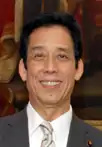Tatsuo Kawabata
Tatsuo Kawabata (川端 達夫, Kawabata Tatsuo, born January 24, 1945) is a Japanese former politician from the Democratic Party, and a member of the House of Representatives in the Diet (national legislature) from 1986 to 2017. A native of Ōmihachiman, Shiga, he attended Kyoto University and received a master's degree from it. His elder brother is former mayor of Omihachiman Gohei Kawabata. In September 2011 he was appointed as Minister of Internal Affairs and Communications in the cabinet of newly appointed prime minister Yoshihiko Noda.[1] He was relieved from the post on 1 October 2012. In September 2017, Kawabata announced that he would not run in the 2017 general election and would retire from politics.
Tatsuo Kawabata | |
|---|---|
川端 達夫 | |
 June 6, 2012 | |
| Vice Speaker of the House of Representatives of Japan | |
| In office 24 December 2014 – 28 September 2017 | |
| Prime Minister | Shinzo Abe |
| Preceded by | Hirotaka Akamatsu |
| Succeeded by | Hirotaka Akamatsu |
| Minister of Internal Affairs and Communications | |
| In office 2 September 2011 – 1 October 2012 | |
| Prime Minister | Yoshihiko Noda |
| Preceded by | Yoshihiro Katayama |
| Succeeded by | Shinji Tarutoko |
| Personal details | |
| Born | 24 January 1945 Gamō, Shiga, Japan |
| Political party | Democratic Party |
| Alma mater | Kyoto University |
Life
Born in Gamo-gun, Shiga prefecture (now Omihachiman city ). The birthplace ran a pharmacy . Graduated from Shiga Prefectural Hikone East High School, Kyoto University Faculty of Engineering. Joined Toray after completing a master's program at the Graduate School of Engineering, Kyoto University. Besides being involved in development research, he also worked on the trade union movement.
Notes and references
- Japan Times, "Cabinet Profiles: Noda Cabinet", 3 September 2011, p. 3.
- 政治家情報 〜川端 達夫〜. ザ・選挙 (in Japanese). JANJAN. Retrieved 2007-10-20. External link in
|work=(help)
External links
- Official website in Japanese.
| House of Representatives of Japan | ||
|---|---|---|
| Preceded by Sōsuke Uno Ganri Yamashita Kōichi Noguchi Hiroyoshi Sezaki Hachirō Nishida |
Member of the House of Representatives from the Shiga At-large district 1986–1996 Served alongside: Masayoshi Takemura, Ganri Yamashita, Sōsuke Uno, Tsutomu Yamamoto |
Constituency abolished |
| New constituency | Member of the House of Representatives from Shiga 1st district (single-member) 1996–2005 |
Succeeded by Kenichiro Ueno |
| Preceded by 29-member block |
Member of the House of Representatives from the Kinki proportional block 2005–2009 |
Succeeded by 29-member block |
| Preceded by Kenichiro Ueno |
Member of the House of Representatives from Shiga 1st district (single-member) 2009–2012 |
Succeeded by Toshitaka Ōoka |
| Preceded by 29-member block (vacancy created by Taizō Mikazuki, DPJ list) |
Member of the House of Representatives from the Kinki proportional block 2014–2017 |
Succeeded by Yukiko Kada |
| Political offices | ||
| Preceded by Ryū Shionoya |
Minister of Education, Culture, Sports, Science and Technology 2009–2010 |
Succeeded by Yoshiaki Takaki |
| Preceded by Naoto Kan |
Minister of State for Science and Technology Policy 2010 |
Succeeded by Banri Kaieda |
| Preceded by Yoshihiro Katayama |
Minister of Internal Affairs and Communications 2011–2012 |
Succeeded by Shinji Tarutoko |